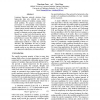Free Online Productivity Tools
i2Speak
i2Symbol
i2OCR
iTex2Img
iWeb2Print
iWeb2Shot
i2Type
iPdf2Split
iPdf2Merge
i2Bopomofo
i2Arabic
i2Style
i2Image
i2PDF
iLatex2Rtf
Sci2ools
ICDM
2003
IEEE
2003
IEEE
Structure Search and Stability Enhancement of Bayesian Networks
Learning Bayesian network structure from large-scale data sets, without any expertspecified ordering of variables, remains a difficult problem. We propose systematic improvements to automatically learn Bayesian network structure from data. First, we propose a linear parent search method to generate candidate graph. Second, we propose a formal approach to eliminate cycles using minimal likelihood loss, a short cycle first heuristic, and a cut-edge repairing. Third, we propose structure perturbation to assure the stability of the network. This step also suggests a stabilityenhancement method to refine the network structure. The algorithms are easy to implement and efficient for large networks. Experimental results on two data sets show that our new approach outperforms existing methods.
Bayesian Network Structure | Data Mining | Data Sets | ICDM 2003 | Learning Bayesian Network Structure |
| Added | 04 Jul 2010 |
| Updated | 04 Jul 2010 |
| Type | Conference |
| Year | 2003 |
| Where | ICDM |
| Authors | Hanchuan Peng, Chris H. Q. Ding |
Comments (0)

